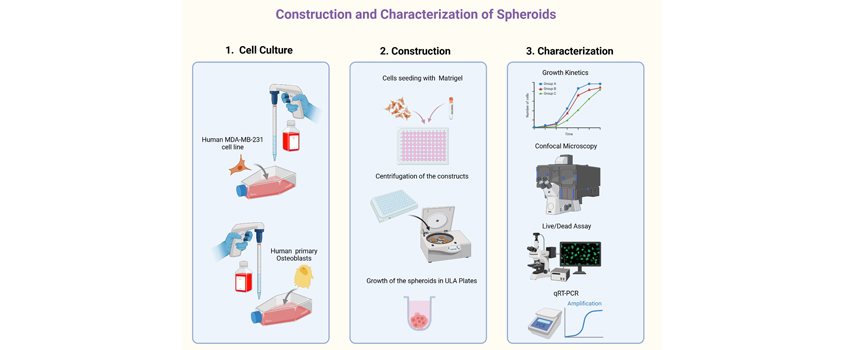2025 Volume No 52 – pages 44-57
Title: Generation of three-dimensional (3D) breast cancer bone metastasis model for drug testing |
Authors: H Nasser, A Aszodi, S Otto, R Fliefel |
Address: Department of Orthopaedics and Trauma Surgery, Musculoskeletal University Center Munich (MUM), Ludwig-Maximilians-University (LMU), 81252 Planegg, Germany; Department of Oral and Maxillofacial Surgery, Faculty of Dentistry, Cairo University, 11553 Cairo, Egypt; Department of Oral and Maxillofacial Surgery and Facial Plastic Surgery, University Hospital, Ludwig-Maximilians-University (LMU), 80337 Munich, Germany; Department of Oral and Maxillofacial Surgery, Faculty of Dentistry, Alexandria University, 21521 Alexandria, Egypt |
E-mail: Nasser.Mansour at med.uni-muenchen.de; Riham.Fliefel at med.uni-muenchen.de |
Abstract: Background: In cancer research, the multicellular tumour spheroids (MCTSs) model has attracted great attention as a transitional stage between in vitro two-dimensional (2D) cultures and in vivo studies, contributing to a better understanding of tumour biology. The objective of this study was to construct three-dimensional (3D) homotypic bone and cancer spheroids together with heterotypic spheroids resembling breast cancer metastasis to the bone. Methods: To construct spheroid models, cells were seeded in ultra-low attachment (ULA) plates with varying concentrations of Matrigel followed by forced aggregation via centrifugation. The models were validated by growth kinetics, cell viability and quantitative real-time polymerase chain reaction (RT-qPCR). Results: The addition of Matrigel allowed the formation and growth of the spheroids. Matrigel enhanced the circularity of the spheroids for homotypic cancer spheroids but significantly reduced their viability. Matrigel had the opposite effect on homotypic bone spheroids, significantly improving viability and negatively affecting circularity. The formation of heterotypic spheroids with 1 % Matrigel represented the optimum condition with high viability and circularity index. The model was subsequently validated to accurately represent bone metastasis via the upregulation of the pro-metastatic genes. Conclusions: Incorporating Matrigel as an extracellular matrix (ECM) protein mixture into spheroid models is crucial as it enhances cellular interactions and is the key to simulating in vivo conditions. Consequently, we constructed a 3D heterotypic tumour spheroid model using 1 % Matrigel as a robust and versatile model to study different aspects of breast cancer metastasis to the bone and for further drug testing. |
Keywords: Bone, metastasis, breast cancer, extracellular matrix, spheroids, three-dimensional, Matrigel, osteoblasts. |
Publication date: 23rd July 2025 |
Copyright policy: © 2025 The Author(s). Published by Forum Multimedia Publishing, LLC. This article is distributed in accordance with Creative Commons Attribution Licence (http://creativecommons.org/licenses/by/4.0/). |
Article download: Pages 44-57 (PDF file) |

